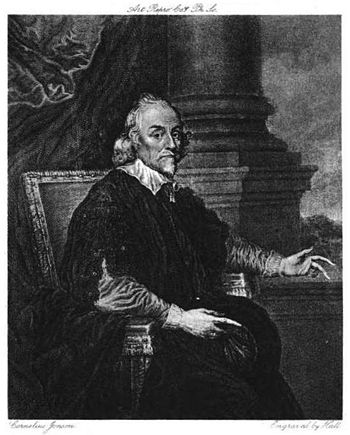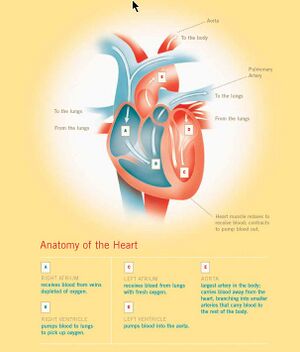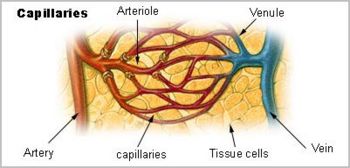William Harvey

William Harvey. From book of that name by D'Arcy Power, 1897
A late 16th, early 17th century English anatomist, physiologist, and physician, William Harvey (1578-1657) bestowed on humanity one of the most important advances in the history of medical science — an explanation of the core physiology of the human cardiovascular system. In part by introducing quantitative methods into anatomical and physiological investigations, Harvey discovered that the left ventricle of the heart pumps blood through the body, doing so via a system of vessels such that the blood moves in a circular path,[1] from the left side of the heart through the arteries and back to the right side of the heart through the veins, transiting from the right side of the heart to the left via blood vessels in the lung, the two sides of the heart separated by a blood-impermeable septum. He published those findings in his 1628 book, Exercitatio Anatomica de Motu Cordis et Sanguinis in Animalibus (Anatomical Exercises on the Motion of the Heart and Blood in Animals), usually referred to as De Motu Cordis.[2] [3] [4]

Anatomy of the Human Heart.
In his dissections of humans and animals, Harvey could not see vessels connecting the arteries to the veins, since, as it turns out, their minute size lies below the limits of visual acuity, even with the magnifying glass he used in his work. He had no access, and perhaps no knowledge, of the existence of microscopes, however primitive their state. Harvey could only infer that a connecting pathway existed. In 1661, a few years after Harvey died, the Italian biologist, Marcello Malpighi (1628-1694), using one of the early microscopes, discovered capillaries, tiny blood vessels not visible to the naked eye, connecting arteries to veins. In a seemingly fitting coincidence, Malpighi had entered the world the same year Harvey published De Motu Cordis.
Among three men, Andreas Vesalius (1514-1564), William Harvey (1578-1657), and Marcello Malpighi (1628-1694), in works published in little more than a century apart, from 1543 to 1661, demonstrated central truths of human anatomy and physiology that had escaped Western medicine for more than a millenium following the erroneous teachings of the influential Greek physician, Galen of Pergamum(130-216 CE). It required three investigators to break the stranglehold of one.
William Harvey’s Major Contributions
Adapted from Sherwin B. Nuland (2008)[5]
- He overturned the erroneous view of the roles of the heart, arteries and veins that Galen had taught — by delineating the cardinal features of the map depicting the transport path of blood through the body — that blood circulates continuously through the body from the heart and back to the heart; Harvey writes:
And now returning to my immediate subject, I go on with what yet remains for demonstration, viz., that in the more perfect and warmer adult animals, and man, the blood passes from the right ventricle of the heart by the pulmonary artery, into the lungs, and thence by the pulmonary veins into the left auricle, and from there into the left ventricle of the heart. And, first, I shall show that this may be so, and then I shall prove that it is so in fact. De Motus Cordis, Chapter VI: Of The Course By Which the Blood Is Carried
First of all, the auricle contracts, and in the course of its contraction forces the blood (which it contains in ample quantity as the head of the veins, the store-house and cistern of the blood) into the ventricle, which, being filled, the heart raises itself straightway, makes all its fibres tense, contracts the ventricles, and performs a beat, by which beat it immediately sends the blood supplied to it by the auricle into the arteries. The right ventricle sends its charge into the lungs by the vessel which is called vena arteriosa, but which in structure and function, and all other respects, is an artery. The left ventricle sends its charge into the aorta, and through this by the arteries to the body at large. De Motu Cordis, Chapter V: Of The Motion, Action And Office Of The Heart
- He reintroduced the concept and practice of experimentation in medical studies, earlier introduced by Galen but mostly ignored by medical researchers for nearly one and a half millennia;
- He introduced the use of quantitative methods in medical research — by estimating the volume of blood pumped by the heart each day and arguing the improbability that the body could generate that amount each day, even if it converted to blood everything ingested each day. Psychologist and science journalist, Robert E. Adler, gives a elegant description:
The breakthrough came when Harvey started to think in terms of numbers—for the first time in the history of medicine. He knew that the left ventricle of the human heart expelled about two ounces of blood with each contraction. If the heart beat 72 times a minute, in one hour it would pump 540 pounds of blood—three times the weight of a grown man. With that simple calculation he ended two millennia of speculation. The liver could not possibly generate more than a person's entire weight in blood in an hour. And however it was generated or utilized, that much blood could not be on a one-way trip to the periphery of the body. So much blood could be moving through the body only if it was being recycled. "I began to think there was a sort of motion as in a circle," he wrote, in what now sounds like a thunderous understatement. [6]
- Harvey introduced his quantitation method in De Motu Cordis with these words:
Thus far I have spoken of the passage of the blood from the veins into the arteries, and of the manner in which it is transmitted and distributed by the action of the heart; points to which some, moved either by the authority of Galen or Columbus, or the reasonings of others, will give in their adhesion. But what remains to be said upon the quantity and source of the blood which thus passes is of a character so novel and unheard-of that I not only fear injury to myself from the envy of a few, but I tremble lest I have mankind at large for my enemies, so much doth wont and custom become a second nature. Doctrine once sown strikes deep its root, and respect for antiquity influences all men. Still the die is cast, and my trust is in my love of truth and the candour of cultivated minds. Chapter VIII: Of The Quantity Of Blood Passing Through The Heart
- Independently of his contemporary, Francis Bacon, he showed that reasoning by induction — generalizing from a collection of separate but related facts — could yield valid inferences about human physiology. Harvey writes:
Since all things, both argument and ocular demonstration, show that the blood passes through the lungs, and heart by the force of the ventricles, and is sent for distribution to all parts of the body, where it makes its way into the veins and porosities of the flesh, and then flows by the veins from the circumference on every side to the centre, from the lesser to the greater veins, and is by them finally discharged into the vena cava and right auricle of the heart, and this in such a quantity or in such a flux and reflux thither by the arteries, hither by the veins, as cannot possibly be supplied by the ingesta, and is much greater than can be required for mere purposes of nutrition; it is absolutely necessary to conclude that the blood in the animal body is impelled in a circle, and is in a state of ceaseless motion; that this is the act or function which the heart performs by means of its pulse; and that it is the sole and only end of the motion and contraction of the heart. De Motu Cordis, Chapter XIV: Conclusion of the Demonstration of the Circulation
Brief sketch of Williams Harvey’s life
Born in 1578 (April 1, at Folkstone, on the east coast of Kent, England), of Thomas and Joan Harvey, as the eldest of seven brothers and two sisters (a "week of brothers" and a "brace of sisters"), William Harvey entered the world shortly after Andreas Vesalius (1514-1564) had died, though Vesalius's reputation had not died, owing to his remarkably detailed and elegantly drawn illustrations revolutionizing the understanding of human anatomy.[7] [8] [9] For his anatomical work, William Harvey had Vesalius's giant shoulders to stand on, and ultimately he saw further.
Harvey received his early education in the classics, in Canterbury, at King's School (1588-1593), there "....admonished to speak Greek or Latin even on the playground." [6] Harvey's father, a landowner and successful merchant, could afford to send Harvey to the University of Cambridge (specifically, Gonville and Caius College), which he entered at age 16 years (1593) and received his Bachelor of Arts (B.A.) degree at age 19 years (1597). Harvey developed an interest in medicine and decided to go to Italy, one of the major centers of intellectual activity in Europe at the time. He enrolled in the then renown University of Padua, studying medicine under Hieronymus Fabricius of Aquapendente, a noted anatomist in the Vesalian tradition, who had discovered the valves in the veins, a discovery which later contributed to Harvey's thinking that led to his discovery of the blood circulatory system.[10] Harvey's earlier education in the classics helped ease his learning at Padua, as lecturers spoke in Latin. Harvey received his Doctor of Medicine degree in April, 1602, at age 24 years.[11]
After Padua, Harvey returned to England and developed a practice in medicine, married, and became a Fellow of the College of Physicians in London. He also secured a position as physician at St. Bartholomew’s Hospital, one of London’s great hospitals, and there and in his private practice distinguished himself as a physician. In 1615, at age 37 years, the College of Physicians elected him their Professor of Anatomy and Surgery, and gave him the honor of the Lumleian Lectureship, a lifetime remunerated position, in which he lectured on human anatomy, physiology and surgery, including performing demonstration dissections on human corpses, officially twice per week, from 1616 to 1656, the year before he died. The lecturership gave Harvey a great opportunity to organize his thinking and guide his research. His lecture notes survive as Lectures on the Whole of Anatomy as a manuscript in the British Library and in English translation.[12]
It is from the fabric of these short notes on the heart that De Motu Cordis was to be built. From 1616 until after the publication of De Motu Cordis there is no contemporary account of the impact of Harvey's lectures on his audience. However, in the Royal College of Physicians there is a manuscript of the anatomical lectures given by Baldwin Hamey (1600-1676), one of the great benefactors of the College, on January 22, 24, and 25, 1647/48. The manuscript, in Hamey's hand, gives us an excellent picture not only of the author's learning but also of the full content of lectures of this type. He had attended Harvey's lectures and obviously profited from them. When discussing the movement of the blood, Hamey gives a discussion on the theories put forward by the ancients and his predecessors and then says:[13]
From the left ventricle, it is, as I sayd, expel'd by the arteries into the whole body; and there, till of late yeares, it was thought to rest, nor was there any further heed taken, or account given of it, than this; that it served for nutrition and augmentation, for generation of spirits and of sperme in their due times. But now by the conduct of our renowned Professor and Colleague Dr. Harvey, there is a way found to bringe the greatest part back againe, and yet no part of the foresaid worke left undone. So that now we truely know what . . . is meant by Circularis Disciplina, for it may be shew'd us in every body that hath a Heart.
In 1618 Harvey became physician extraordinary to the king (James I), and ministered to many eminent aristocrats, including Francis Bacon, for whom he had little regard as an intellectual. After Charles I succeeded the throne, in 1625, Harvey became Charles' physician, benefitting from the King’s patronage to pursue his medical investigations. When civil strife engulfed England, Harvey, now in his 60s retired to live with a brother, pursuing his experiments until he died in 1657, having lived nearly to the age of 80 years.[14] [15]
De Motu Cordis
To read the full-text of De Motu Cordis in English translation, click on the "Works" tab in the banner at the beginning of this page. Equivalently, click De Motus Cordis, which brings you to same subpage of this article. A few revelatory quotes from the work:
True philosophers, who are only eager for truth and knowledge, never regard themselves as already so thoroughly informed, but that they welcome further information from whomsoever and from wheresoever it may come; nor are they so narrow-minded as to imagine any of the arts or sciences transmitted to us by the ancients, in such a state of forwardness or completeness, that nothing is left for the ingenuity and industry of others.
And no one denies the blood as such, even the portion of it which flows in the veins, is imbued with spirits. But if that portion of it which is contained in the arteries be richer in spirits, it is still to be believed that these spirits are inseparable from the blood, like those in the veins; that the blood and spirits constitute one body (like whey and butter in milk, or heat in hot water), with which the arteries are charged, and for the distribution of which from the heart they are provided.
Of course, we now know that the richer 'spirit' in arterial blood is oxygen. Before the discovery of oxygen, the alchemists of the seventeenth century recognized that air contained an essential ingredient, an 'elixir of life' — a kind of 'spirit'. We also know today that venous blood, too, has its richer 'spirit', carbon dioxide (as bicarbonate).
De Generatione Animalium
Harvey received less repute for his other great work, De Generatione Animalium — On the Generation of Animals — a contribution to embryology....
References cited and notes
- ↑ Note: Not 'circular' in the strict geometrical sense of all points on the path equidistant from a center, but in the sense of a closed curve of irregular shape though with end-point and start-point at the same place.
- ↑ Harvey W. (1628) On the Motion of the Heart and Blood in Animals. Translation: Robert Willis. The Internet Modern History Sourcebook. Paul Halsall, halsall@fordham.edu, Sourcebook Compiler.
- ↑ Note: Read the full-text of Robert Wills' English translation of De Motu Cordis in this Citizendium article's subpage, Works (click Works tab at top of this page, or click here).
- ↑ Harvey W. (1628) EXERCITATIO ANATOMICA DE MOTU CORDIS ET SANGUINIS IN ANIMALIBUS. Facsimile of original, with English translation and Annotations by Chauncey D. Leake, Professor of Pharmacology, University of California San Francisco. Tercentennial Edition. Charles C. Thomas: Springfield IL. Full-Text viewable online or via free PDF download. Courtesy Biodiversity Heritage Library.
- ↑ Nuland SB. (2008) Doctors: The History of Scientific Medicine Revealed Through Biography. The Teaching Company. (12 lectures, 30 minutes/lecture), Course No. 8128.
- ↑ 6.0 6.1 Adler RE. (2004) Medical Firsts: From Hippocrates to the Human Genome. Hoboken NJ: Wiley.
- ↑ The Galileo Project: Harvey, William
- Note: Scholarly summary of William Harvey's life and work, extensively referenced.
- ↑ William Harvey (2008) Encyclopedia Britannica Online Free Full-Text Article edited by British physician, surgeon, medical historian and bibliophile, Sir Geoffrey Langdon Keynes
- ↑ Sir D´Arcy Power. (1897) William Harvey [Free full-text Google book. T. Fisher Unwin:London
- ↑ Note: Fabricius did not call them valves, but 'little doors', not completely closed doors, closed just enough to slow down the blood flow as it flowed away from the heart, opposite of its true direction of flow but in the direction Galen had taught that it flowed.
- ↑ Note: Of interest, Galileo was Professor of Mathematics at the University of Padua when Harvey was a student there.
- ↑ Harvey W. (1961; originally written 1616-?) Lectures on the Whole of Anatomy: An Annotated Translation of Prelectiones Anatomiae Universalis. C. D. O'Malley - transltr, F. N. L. Poynter - transltr, K. F. Russell - transltr. University of California Press. Berkeley, CA.
- From the translators' Introduction, page 6: The circumstances attending the production of these lecture notes have never been discussed, but the more closely they are investigated the clearer does it become that many features of them which have been taken for granted are still open to question. They are certainly notes that Harvey prepared for his Lumleian lectures, and, judging by their scope, by the research into the literature which is revealed in the citations, and by the personal observations briefly referred to, Harvey must have spent much time in compiling them.
- ↑ Harvey W. (1961 edition) Lectures on the Whole of Anatomy: An Annotated Translation of Prelectiones Anatomiae Universalis. C.D. O´Malley, transltr; F. N. L. Poynter, transltr; K. F. Russell, transltr. University of California Press: Berkeley, CA. (From the translators' Introduction, page 17)
- ↑ Huxley TH. (1878) William Harvey and the Discovery of the Circulation of the Blood. (A free full-text PDF download) A Lecture delivered in the Free Trade Hall, November 2nd, 1878. From the Project Gutenberg Literary Archive Foundation [Etext #2939].
- ↑ William Harvey (1578-1657). Originally appearing in Volume V13, Page 47 of the 1911 Encyclopedia Britannica.
